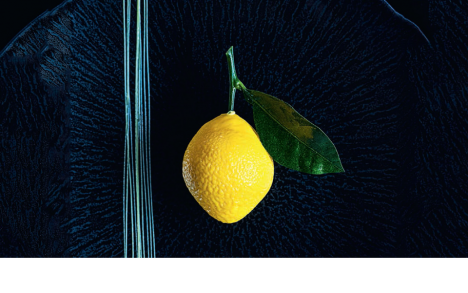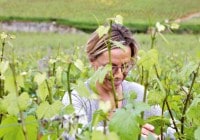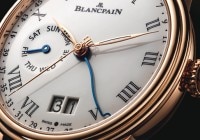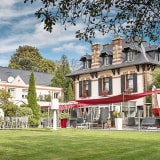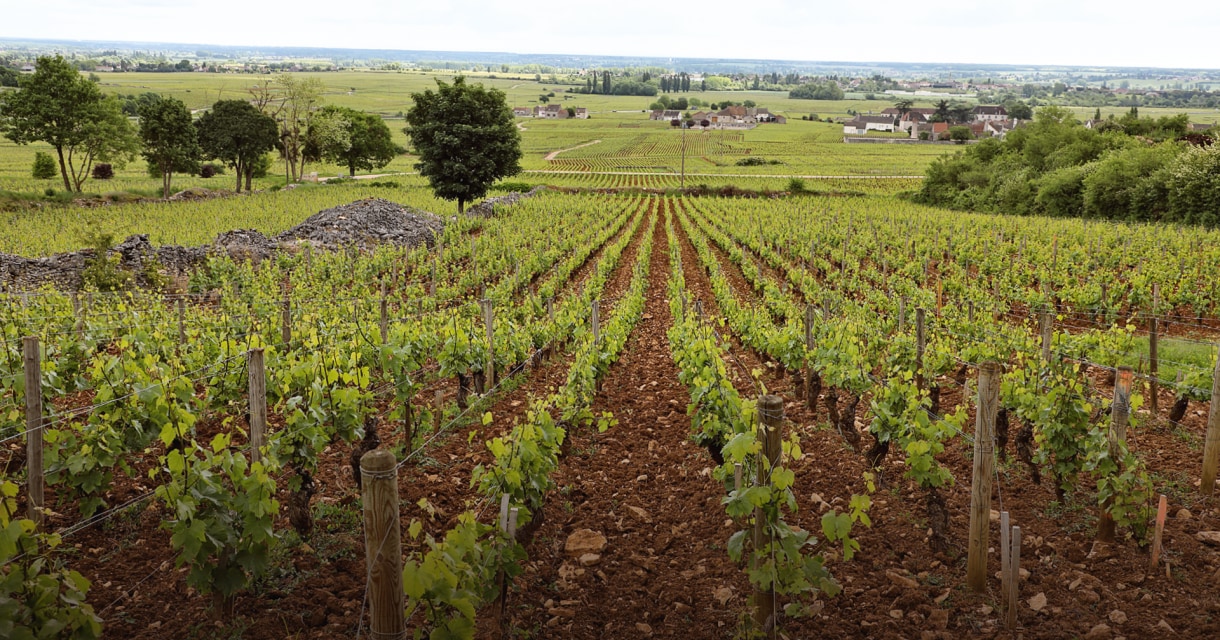
Search in Issues
Chapters
List of parts
Chapter 5
L’Assiette Champenoise
New notions of freshness, purity, and above all intensity of flavor in Reims.

As WINEMAKING IN CHAMPAGNE has evolved so has its CUISINE.
Revolution is such a harsh emotionally charged word. Conjured are images of Robespierre, Bolsheviks, Che and more. There is no quarter given nor relief from hard edges, severity, brutality, or even destruction. But can there be a gentle revolution? One that is tolerant, honors and respects what has gone before, while at the same time, illuminating new ideas that can compatibly co-exist with history and tradition. So broaden your thinking. Add to the list of definitions in your mental dictionary these soothing notions. Holding to those thoughts will guide you to an understanding of today’s Champagne revolution both in its wine and its food. And in the center of it all is the region’s most celebrated restaurant, L’Assiette Champenoise.
Legend has it that Champagne was invented by the Benedictine monk Dom Pierre Pérignon (1638-1715). Although he was responsible for many innovations in winemaking, still wine, not bubbly, was the norm for his era. Indeed, far from devoting himself to the production of sparkling wine, chief among Dom Pérignon’s achievements were methods to prevent effervescence from occurring. Development of the famed méthode champenoise did not arrive until nearly a century and a half after Dom Pérignon’s death, that is to say, in the mid-1800s. Notwithstanding the distortion of history enthusiastically broadcast by the trade, the transformation of winemaking that took place from making still to sparkling wine catapulted Champagne to the forefront in the world of wine and made it an unsurpassed symbol of celebration and luxury. At the same time, it established the primacy of the grand houses: Moët & Chandon, Veuve Clicquot, Taittinger, Laurent Perrier, Roederer, Bollinger, Krug, Pol Roger, Deutz and Piper-Heidsieck. The list is long; the names house-hold words.
And linked to the rise and dominance of these powerhouses came a certain conservatism. Each house guarding its style. Hand in hand with the large houses, the region’s cuisiniers followed their lead and became just as determined not to rock the boat.
Quietly, almost via stealth, small individual boutique producers began blossoming a decade ago. Emphasizing individual vineyards in ways that grand houses with their large production never could or, owing to
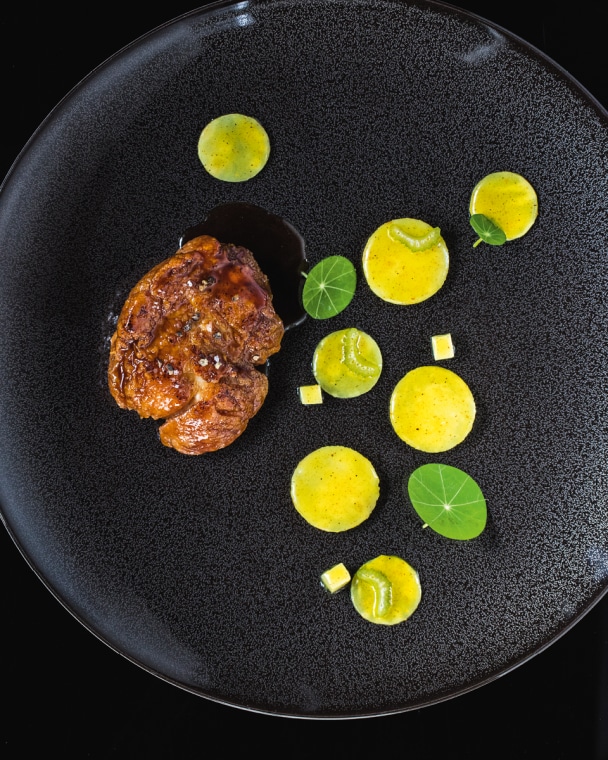
Ris de veau, Crème de persil.
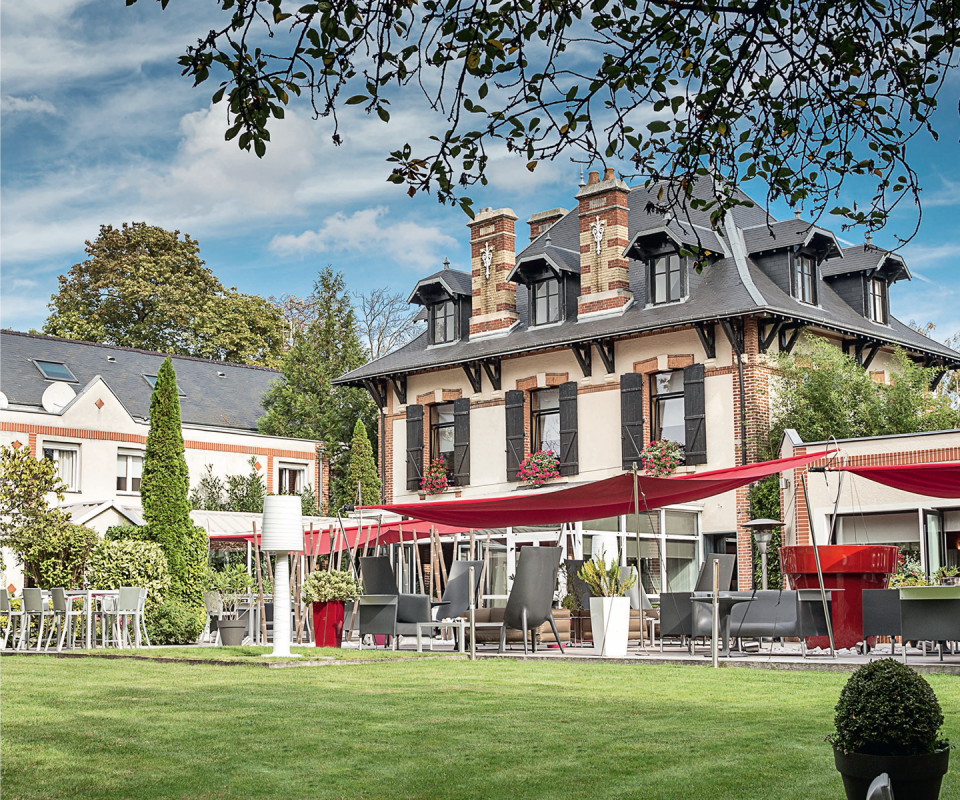
UNIVERSAL ACCLAIM with THREE MICHELIN STARS and 19.5 GAULT & MILLAU POINTS.
their traditions, would never dare, artisanal Champagnes have arrived. Bold expressions of winemaking have brought new dimensions to the notions of what Champagne can be. Of course, the grand houses still offer magnificent cuvées to their devoted followers, but now connoisseurs also speak of vineyard classifications and their rankings as grand cru or premier cru, particular villages in the region, and, of course, the styles of individual winemakers. None of these notions are included in the parlance of the large houses. This is a revolution but a gentle one that exists side by side with tradition.
In many ways, what Arnaud Lallement has achieved in his restaurant L’Assiette Champenoise echoes the breadth that marks today’s Champagne winemaking. Instead of being immovably and inflexibly shackled to the notions of grandeur and formality that formerly defined la grande cuisine champenoise, he has imported to the cooking of Reims new notions of freshness, purity and, above all, intensity of flavor. It is not an exaggeration to say that he has turned the Champagne world topsy-turvy, gently and respectfully, of course. As recently as a decade ago, in the grand restaurants of Reims or neighboring Épernay, it always seemed as if the dishes were conceived never to take the limelight away from the glass of accompanying Champagne. Who would dare upstage a coupe of Krug? The breadth of choices today in Champagne—the wine card at L’Assiette Champenoise offers a staggeringly large
selection of 1,054 different Champagnes!—ranging from austere extra brut cuvées, to ultrasmall production cuvées vividly expressing their terroir, to almost inky dark Pinot Noir cuvées, has allowed Lallement to give full flight to a palette of intensely flavored dishes. Now it is the plate that takes charge and the Champagne is chosen as the counterpoint.
Has he succeeded? The universal acclaim makes the point. Three Michelin stars and 19.5 points awarded by Gault & Millau. Keep in mind that several years ago, Gault & Millau declared that 19 points would be the maximum that could be awarded. A ceiling. But what is a ceiling if it can’t be broken and L’Assiette Champenoise is now one of only three restaurants in all of France that have surpassed the maximum to achieve 19.5.
BLUE LOBSTER Tribute to my dad, 2015
Ingredients
Lobsters
Two 500–600 g blue lobsters
Lobster butter
500 g lobster shells
5 g paprika
100 g butter
Sweet pepper siphon
250 g potatoes
7 g olive oil
7 g smoked paprika
25 cl water
10 cl milk
200 g crème fraîche
10 g salt
Lobster sauce
500 g lobster heads
10 g olive oil
15 g paprika
50 g honey
100 g shallots
37.5 cl dessert wine (Sauternes)
500 g crème fraîche
Potato rounds
200 g potatoes
10 cl lobster sauce
Pommes soufflées
6 Bintje potatoes
Deep fryer with sunflower oil
Champagne vinegar reduction
10 cl Champagne vinegar
3 nasturtium leaves
Chopped sage
Method
Separate uncooked lobster body, pincers and head. Blanch the pincers for 6 mins and the body for 2 mins. Remove the flesh and put it aside. Reheat in the lobster butter just before serving. Chop the extremities and set aside for the presentation.
Gently fry the lobster shell with the paprika. Cover with butter. Cook gently for 1 hour. Sieve. Bring to the boil to clarify. Set aside.
Peel and chop the potatoes. Fry in a little olive oil. Add the sweet pepper and cover with water. Reduce until almost dry. Add the milk, crème fraîche
and the salt. Bring to the boil. Mix and sieve. Pour into a siphon loaded with a cartridge.
Peel and chop the shallot. Fry the lobster heads in olive oil. Add the paprika, honey and shallot. Deglaze with dessert wine. Reduce by half. Cover with water. Cook gently for 1 hour. Add crème fraîche. Sieve. Season to taste.
Peel the potatoes. Set aside one potato. Cut 30 × 6 cm diameter rounds from the others. Blanche for 1 min. Deglaze with the lobster sauce.
Cut the potatoes into 3 mm slices, and then ovals measuring 6 cm by 4 cm wide. Blanch in sunflower oil at 135 °C, basting constantly, and then at
180 °C for 1 min. Sprinkle with salt to taste.
Heat the vinegar and reduce it to the consistency of syrup.
Cut the leaves into four rounds measuring 2, 3 and 4 cm.
Presentation
Place the three rounds of deglazed potatoes on the left side of each plate. Garnish lightly with the chopped lobster, sweet pepper siphon and chopped sage. Cover each round with another round so as to form three ravioli. Place a line of Champagne reduction on the right hand side of the plate. Place the lobster half-tail on it. Stand one pincer upright next to it. Finish with three rounds of nasturtium and three pommes soufflées. Serve the lobster sauce aside on the table.
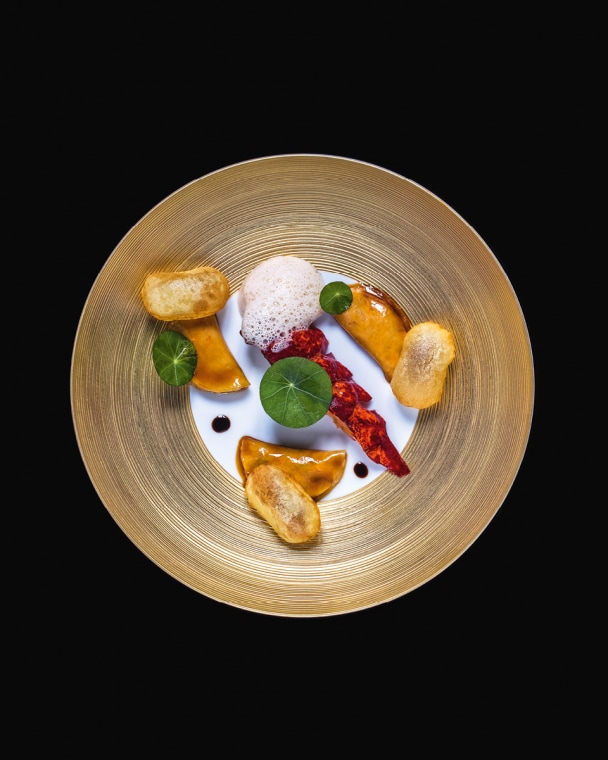

Langoustine royale rôtie.
The adjectives “FRESH” and “PURE” can be overused. Here they are a POWERFUL ALMOST IMPULSIVE reaction to what is on the plate.
It seems that every restaurant and, for that matter, every restaurant review, incants the adjectives “fresh” and “pure”. After all, who dreams of meals that are “stale” and “impure”. So has all meaning been drained from these words to the point that they signify nothing? My handwritten notes from two dinners at L’Assiette Champenoise offer vivid evidence to the contrary, as again and again my impressions and descriptions of the plates, dish after dish, repeated these words writ large and in capital letters. No pondering. No deep searching for what to write. Simply a powerful almost impulsive reaction to what was on the plate.
Lallement’s tomato preparation, simply described as Tomate D. Vecten/Eau de tomates makes the point. We can all rejoice with a serving of ripe summer tomatoes. But Lallement has elevated the genre with perfect cherry tomatoes, peeled and stuffed with tomato concassée. This is a concassée like no other with show stopping vivid intensity of flavor. It is as if, somehow, he had found a 1,000 watt amplifier to take the tomato pulp and extract and concentrate it to an unprecedented degree. His secret is extra long, low temperature cooking to arrive at this ultimate expression of the essence of a perfect tomato. Surrounding the cherry tomato is a nearly luminous red tomato gazpacho and, for a textural crunch counterpoint, small olive oil pommes soufflées. Emphatically demonstrating that this was a tomato preparation like no other, served alongside is a glass of pale yellow tomato water. The color is a disguise, for like the puree on the interior of cherry tomato, it has a freshness and purity (those words again) and an intensity that can only be described as supercharged. What makes this even more remarkable is that he eschews completely the chemical engineering that modern cooks call molecular cuisine. In short, he offers proof of what traditional cooking can achieve when a dish is conceived to communicate without distraction the essence of its star ingredient. Who needs a centrifuge?
Arnaud Lallement’s entire life has been devoted to cuisine, as was that of his father, Jean-Pierre, who in 1975, together his his wife Colette, opened a restaurant named L'Assiette Champenoise in Châlons-sur-Vesle, 10 km from today's location in Tinqueux near Reims. At the age of 17, Arnaud began working in Châlons, where his father had earned his first Michelin star in 1976 just two years after his son's birth. He then studied at the Lycée hôtelier in Strasburg before enhancing his knowledge through several years spent in postings with three-star chefs Roger Vergé, Michel Guérard and Alain Chapel. In 1996, Arnaud returned to work with his parents, who had meanwhile relocated their establishment in Tinqueux as a hotel-restaurant. Following Jean-Pierre’s sudden death in 2002 at the age of but 50 years, Arnaud took charge of the stoves and the restaurant began its ascent up the Michelin ladder, garnering its second star in 2005 and the third in 2014.
He describes his cuisine as “contemporary” and “pure” (there’s that word again) and is firm in saying that he is not modern. Thus, no molecular transformations. No sous vide. To achieve the purity that is his polestar, Arnaud conceives his preparations to showcase never more than two ingredients and, in most cases, only one ingredient. That is not to say that his dishes are simple. Paging through his cookbook confirms that his preparations are staggeringly complex. They just don’t appear to be. What pops into mind is Winston Churchill’s famous observation, “Out of intense complexity, intense simplicities emerge.”
Notwithstanding the encyclopedic wine list with its 1,054 choices neatly organized and searchable upon the iPads presented to the diners by the sommeliers, the finest way to experience an adventure of both food and wine here is to order the tasting menu accompanied by a different Champagne with every course. Not only will each glass marry perfectly with the parade of plates, but the journey will span the breadth of today’s Champagne winemaking: artisanal small producers, small production still wine, large house Champagnes including cuvées prestige, rosés of different styles. One important note. Great Champagnes are not merely bubbles, but at their core are made of fine wine with all the nuances, depth and complexity of prestigious Burgundies or Bordeaux. The flutes that tend to be favored as stemware outside of the region conspire against letting the wine of Champagne completely express itself. Offering a lesson, that hopefully will be adopted more widely, Champagne at L'Assiette Champenoise is served in red wine glasses giving full flight to its aromas and flavors.
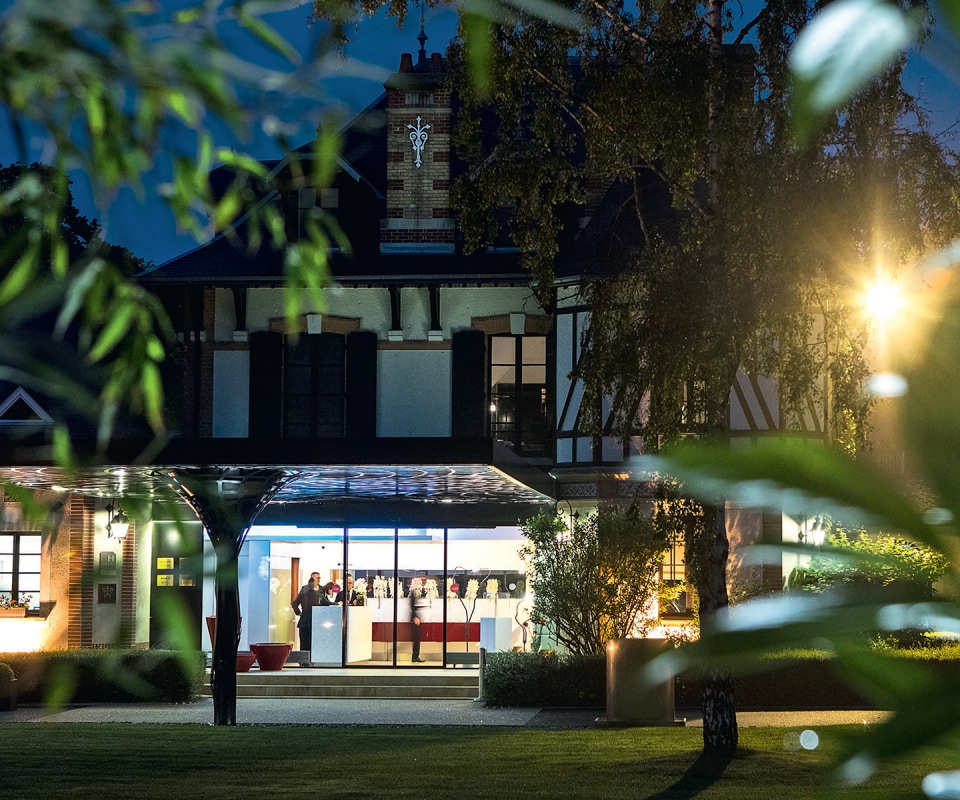
Weather permitting, a meal begins with an aperitif on the restaurant's lovely terrace nestled into a quiet garden. Particularly if one has chosen the tasting menu with matching wines, dispensing with the burden of reading and choosing, one can settle in with the soothing breezes wafting in from the garden. Of course, perfecting the beginning of the meal, always a glass of Champagne accompanied by an armada of small bites (recently, a delicate pastry with red pepper mousse, an ethereal sponge cake of parsley topped with puffed rice and citrus; sugar and salt cured salmon, and magnificently light but intensely flavored croustillants de parmesan).
After the garden interlude, moving into the dining room, which blends svelte contemporary decor with a magnificent belle époque chandelier, Lallement always begins with a nod toward Champagne tradition with a potée Champenoise. This is a delicate confit of pork accented by mustard grains and topped with crusty pastry round and crisp radish, cauliflower, turnips and carrots, all floated upon an earthy vegetable stock. It represents an elevation of rustic country cooking to three-star status.
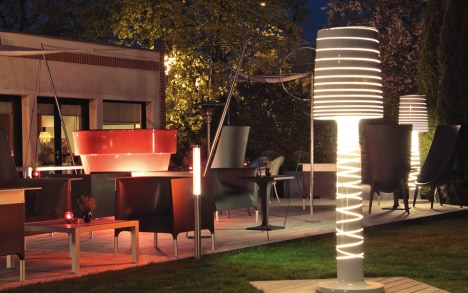
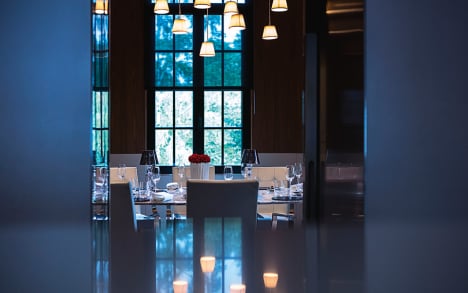
Unlike many temples of gastronomy that relegate vegetables to supporting roles, LALLEMENT devotes ENTIRE COURSES to them.
Unlike many temples of gastronomy that relegate vegetables to supporting roles, Lallement devotes entire courses to them. His ethereal tomato dish is a perfect example. So, too, are his Courgette B. Deloffre/Epices and Petits pois/Herbe à curry. The courgettes were miniature in size and al dente, served with a deeply flavored and rich parsley sauce. The pea dish was a cold/warm preparation with a bright sweet pea sorbet, surrounded by a lukewarm pea sauce with just a bare hint of curry. Texture came with a few grains of puffed rice. The ensemble was essence of peas “squared”, deep, fresh and concentrated.
Two shellfish preparations demonstrated the extreme precision of his cooking. Homard Bleu/Hommage à mon papa is just that, an update on a dish his father first created in 1978. A giant perfectly cooked lobster tail cooked until just barely translucent was juxtaposed next to a potato ravioli filled with bits from the claw, all napped in a rich shellfish stock/Sauternes sauce. This is a dish for those who revel in lobster. Langoustine royale rôtie with its simply roasted giant body set on its plate next to a generous spoonful of what, before tasting, appeared as if it were mayonnaise, was deceptive in its visual austerity. The “mayonnaise” was not mayonnaise at all, but deeply flavored, concentrated essence of langoustine with olive oil, rendered slightly spicy by grapefruit pepper. The depth of flavor was riveting.
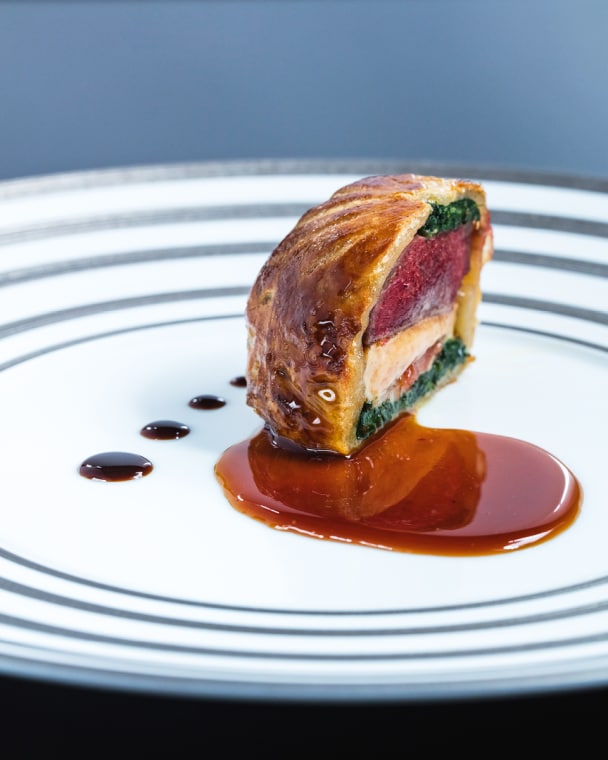
Pigeonneau fermier/En tourte/Caillette.

Caviar Kavari/Haddock/Pomme de terre.
Caviar is a natural foil for Champagne and of course Lallement offers his unique riff on the theme. Departing from the convention where caviar opens a meal, Arnaud places his Caviar Kaviari/Haddock/Pomme de terre in the middle of a tasting menu. He offered a brilliant pair of foils for the caviar: barely warmed smoky haddock and cloud-like warm potato mousse. Both served as backgrounds leaving the caviar, where it should be, center stage.
A fish standout was Saint-Pierre de Petit Bateau/Ponzu crémeux. Saint-Pierre (John Dory) is a delicate fish which always calls out for a complement to bring interest. The ponzu sauce, exotic, smoky, deep and rich, did just that. Balancing were roasted aubergines topped with Mexican tarragon and pâte miso, which is derived from soy and watermelon. The watermelon was the brilliant touch with its interplay against the smoky fermented accents and the richness.
Another salute to Jean-Pierre Lallement remains a standard, Pigeonneau fermier/En tourte/Caillette. This recipe is the last one that Arnaud and his father created together. More often than not, preparations en croûte disappoint more than they enchant and, at worst, the croûte serves only to distract from what it houses. Banish the thought. Lallement’s croûte is thin, light, delicate, and, best of all, fully maintains its crispness. In short, it imparts texture to the layered cooked rare pigeon, foie gras and Swiss chard in the interior. As miraculous as the croûte was, the jus alongside astonished with its otherworldly concentration and intensity. Thoroughly convinced more pigeons went into the sauce than ever saw the insides of the croûte.
Ris de veau/Crème de persil is a fixture at l'Assiette Champenoise. A majestically large sweetbread with a bronzed caramelized exterior and cloud-like interior is served with its jus de cuisson brightened with parsley. Fitting to the grandeur of this sweetbread, the sommelier paired it with a glass of Krug.
L’Assiette Champenoise has become a POWERFUL BEACON and AMBASSADOR for what Champagne should represent.
Dessert at L’Assiette Champenoise is its own mini tasting menu. Plates appear groaning with perfectly crisp and light Cannelés de Bordeaux, fruit jellies, and chocolate domes. Then the centerpiece arrives.
A standout is Amande/Miel. The description hides the genius and delicacy of the preparation. This is a yin/yang dessert with its crisp honeycomb delivering texture and playing off almond ice cream, honey, and a deep intense cherry sauce.
In the face of the lamentable habit of sportsmen spraying Champagne on teammates or any other soul in range, a practice invented by American driver Dan Gurney celebrating Ford’s 1,2,3 sweep of Le Mans in 1966, which has served to coarsen Champagne’s mystique, L’Assiette Champenoise has become a powerful and important beacon and ambassador for what Champagne should represent. Excellence, refinement, and sophistication. More than that, L’Assiette Champenoise is a must for devotees of food and wine. •
